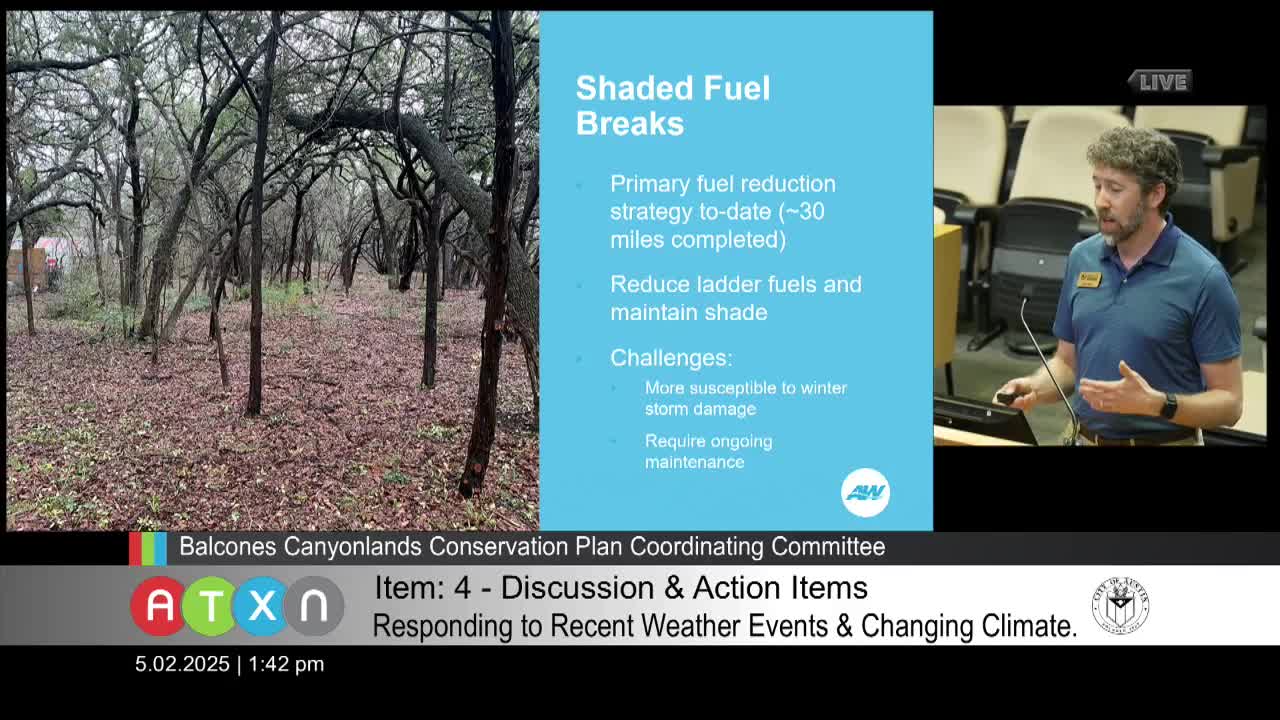Austin collaborates on wildfire risk mitigation and community resilience strategies
May 02, 2025 | Austin, Travis County, Texas
This article was created by AI summarizing key points discussed. AI makes mistakes, so for full details and context, please refer to the video of the full meeting. Please report any errors so we can fix them. Report an error »

The Austin Balcones Canyonlands Conservation Plan Coordinating Committee convened on May 2, 2025, to discuss critical strategies for enhancing wildfire resilience in the region. The meeting focused on collaborative efforts between public and private sectors to create a cohesive approach to landscape management and risk mitigation.
Key discussions centered on the identification and prioritization of shaded fuel breaks, particularly in areas where homes are in close proximity to wildland boundaries. Committee members emphasized the importance of targeting these breaks where they can have the most significant impact, especially in residential areas located within 30 feet of wildland edges.
A detailed analysis of wildfire data revealed ignition corridors, with a heat map indicating where fires typically start. Most incidents were attributed to human activity, particularly along roadway corridors where careless actions, such as discarding cigarettes or dragging chains, can ignite fires. The committee underscored the need for strategic fuel mitigation efforts in these high-risk areas to support emergency responders in effectively managing fire outbreaks.
Technological advancements, including remote sensing and LIDAR overflights, were highlighted as tools to assess canopy loss and identify areas with accumulated dead material. This data will help prioritize conservation efforts across the vast landscape of over 30,000 acres.
The committee reiterated the importance of partnerships among city, county, and various land management organizations to foster resilient neighborhoods and landscapes. Collaboration with first responders and community members was deemed essential for successful fire management and prevention strategies.
In conclusion, the meeting underscored a proactive approach to wildfire risk management, emphasizing strategic planning, community involvement, and the utilization of technology to enhance the resilience of the Balcones Canyonlands area.
Key discussions centered on the identification and prioritization of shaded fuel breaks, particularly in areas where homes are in close proximity to wildland boundaries. Committee members emphasized the importance of targeting these breaks where they can have the most significant impact, especially in residential areas located within 30 feet of wildland edges.
A detailed analysis of wildfire data revealed ignition corridors, with a heat map indicating where fires typically start. Most incidents were attributed to human activity, particularly along roadway corridors where careless actions, such as discarding cigarettes or dragging chains, can ignite fires. The committee underscored the need for strategic fuel mitigation efforts in these high-risk areas to support emergency responders in effectively managing fire outbreaks.
Technological advancements, including remote sensing and LIDAR overflights, were highlighted as tools to assess canopy loss and identify areas with accumulated dead material. This data will help prioritize conservation efforts across the vast landscape of over 30,000 acres.
The committee reiterated the importance of partnerships among city, county, and various land management organizations to foster resilient neighborhoods and landscapes. Collaboration with first responders and community members was deemed essential for successful fire management and prevention strategies.
In conclusion, the meeting underscored a proactive approach to wildfire risk management, emphasizing strategic planning, community involvement, and the utilization of technology to enhance the resilience of the Balcones Canyonlands area.
View full meeting
This article is based on a recent meeting—watch the full video and explore the complete transcript for deeper insights into the discussion.
View full meeting
